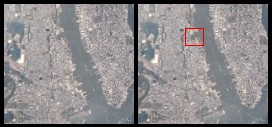Weehawken Cove

Weehawken Cove is a body of cove on the west bank of the Hudson River between the New Jersey municipalities of Hoboken to the south and Weehawken to the north. At the perimeter of the cove are completed sections the Hudson River Waterfront Walkway, offering views of Manhattan and the Palisades. The name Weehawken comes from the Lenape, and can translate as "at the end of",[1] either the Hudson Palisades or the stream which flowed from them into the cove, later the site of the nearby Lincoln Tunnel.
Half Moon
The first European to record visiting the cove was Robert Juet, first mate of the Half Moon captianed by Henry Hudson, who anchored his ship in the cove on October 2, 1609.[2]
He wrote: "we got down two leagues beyond that place and anchored in a bay clear from all danger of them on the other side of the river, where we saw a good piece of ground, and hard by it there was a cliff that looked of the colour of white-green, as though it was either a copper or silver mine, and I think it to be one of them by the trees that grow upon it, for they are all burned, and the other places are green as grass. ' '
The cliff described is now known as Castle Point.
Lipton Tea and Lincoln Harbor

A prominent landmark on the south side of the cove is the Hudson Tea Buildings, a converted residential complex in former plant and warhouse of Lipton Tea. Addtional apartment complexes have been built along the cove in the last decade. The cove is two blocks north of 14th Street (Hoboken). On the north of the Cove is Lincoln Harbor, a residential, commerical, and recreational area on the site of the former Erie Railroad Weehawken Yard, which had partially filled the cove to be built.[3]Proposals to build parks along its western shore were not realized materialized.<ref>http://www.hobokenparks.org/about/1600-park-avenue-overview/<ref> and the land remain unacessible to the public.
References
- ^ Weehawken, Dictionary of American Naval Fighting Ships, accessed June 13, 2007. "A township in Hudson County, N.J., seven miles northeast of Jersy [sic] City. The name was originally an Algonquin Indian term and later changed by folk-usage to a pseudo-Dutch form. Its exact meaning is unclear, but variously translated ... at the end (of the Palisades)..."
- ^ Hoboken's earliest days: Before becoming a city, 'Hobuck' went through several incarnations, Hudson Reporter, January 16, 2005. "On October 2, 1609, Henry Hudson anchored his ship, the Half Moon, in what is now Weehawken Cove. Robert Juet, Hudson's first mate, wrote in the ship's log, "[W]e saw a good piece of ground ... that looked of the color of white green." The rock of which Juet wrote makes up Castle Point in Hoboken; nowhere else along the Hudson River exists a white-green rock formation."
- ^ http://query.nytimes.com/mem/archive-free/pdf?_r=1&res=9C03E3DD133AEF34BC4C53DFB0668382679FDE
